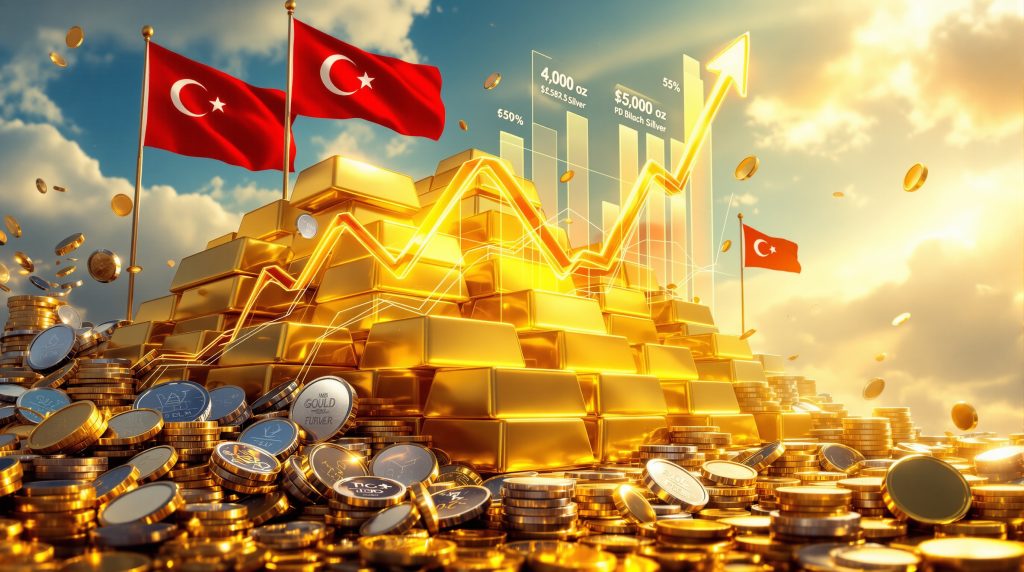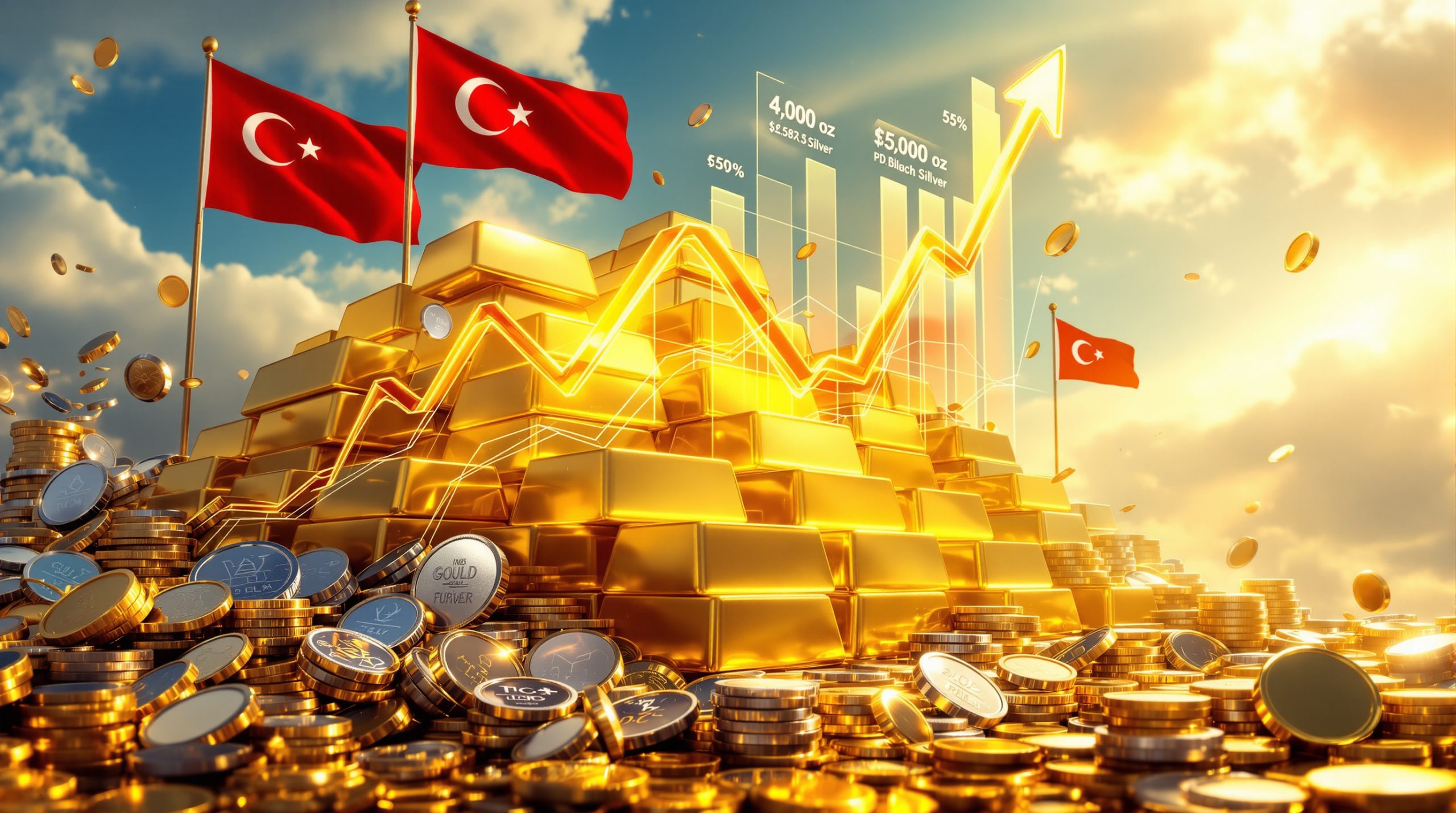Economic uncertainty has emerged as the defining characteristic of modern financial markets, fundamentally altering how institutional investors approach portfolio construction and risk management. Central bank policies worldwide continue to diverge while geopolitical tensions escalate, creating an environment where traditional asset allocation models face unprecedented challenges. Within this context, precious metals markets are experiencing sustained momentum driven by structural forces that extend far beyond typical cyclical patterns, establishing conditions many analysts view as characteristic of a bull market in precious metals.
The convergence of monetary debasement concerns, industrial demand growth, and supply chain constraints has created conditions that many analysts view as supportive of extended upward price movements across the metals complex. Unlike previous commodity cycles driven primarily by speculative flows or temporary supply disruptions, current market dynamics reflect deeper institutional shifts in how central banks, corporations, and individual investors view precious metals within their strategic frameworks.
Understanding Bull Market Dynamics in Precious Metals
Modern precious metals bull markets exhibit distinct characteristics that differentiate them from brief price spikes or speculative bubbles. These sustained upward trends typically feature expanding institutional participation, increasing correlation with monetary policy uncertainty, and gradual shifts in investor behavior toward long-term accumulation strategies rather than short-term trading approaches.
Market Cycle Characteristics and Duration Patterns
Historical analysis reveals that precious metals bull markets tend to unfold over multi-year periods, often lasting between five to fifteen years depending on underlying macroeconomic conditions. The 1970s gold bull market, for example, extended from approximately 1971 to 1980, driven initially by Nixon's closure of the gold window and subsequently by persistent inflation and monetary instability.
The characteristics that distinguish genuine bull markets from temporary price increases include:
• Sustained institutional accumulation over quarters rather than weeks
• Broadening participation across different investor categories
• Correlation with monetary policy uncertainty and currency debasement concerns
• Technical momentum supported by fundamental supply-demand imbalances
• Media attention progression from specialized publications to mainstream coverage
Volume patterns during bull markets typically show steady increases in underlying physical demand, often accompanied by periodic spikes during crisis periods. Unlike equity bull markets that may be driven primarily by earnings growth or valuation expansion, precious metals bull markets frequently reflect currency debasement concerns and safe-haven demand.
Multi-Metal Performance Analysis
The current market environment demonstrates synchronized strength across the precious metals complex, though with varying degrees of momentum. Silver's industrial applications provide additional demand support beyond its monetary characteristics, while platinum benefits from both automotive catalyst requirements and emerging hydrogen economy applications. For comprehensive insights into the relationship between different metals, our gold-silver ratio insights provide detailed analysis of cross-metal performance patterns.
Recent market developments include central bank diversification strategies that extend beyond traditional gold purchases. According to industry reports from November 2025, three major central banks – Russia, India, and Saudi Arabia – have begun incorporating silver into their reserve strategies, marking what analysts describe as silver's return as a monetary metal.
Cross-metal correlation analysis reveals important relationships during different market phases:
| Market Phase | Gold-Silver Correlation | Gold-Platinum Correlation | Industrial vs. Monetary Demand |
|---|---|---|---|
| Early Bull Market | 0.65-0.75 | 0.45-0.55 | Monetary demand leads |
| Mid-Cycle | 0.75-0.85 | 0.55-0.70 | Balanced demand sources |
| Late-Stage | 0.80-0.90 | 0.70-0.85 | Speculative demand peaks |
Macroeconomic Forces Driving Current Market Dynamics
The interaction between monetary policy, fiscal policy, and geopolitical developments creates the foundational conditions that support sustained precious metals bull markets. Unlike traditional asset classes that may benefit from economic growth or corporate earnings expansion, precious metals often perform best during periods of currency instability and institutional uncertainty.
Central Bank Reserve Diversification Strategies
Central bank purchasing patterns have evolved significantly since the 2008 financial crisis, with emerging market central banks leading a sustained accumulation campaign. This trend reflects broader geopolitical shifts toward multipolar reserve systems and concerns about dollar-denominated asset concentration risks.
Key developments in central bank strategy include:
• Asian central bank leadership in physical accumulation programs
• Reserve diversification away from traditional dollar-denominated instruments
• Strategic metals inclusion beyond gold into silver and other precious metals
• Domestic mining support policies to reduce import dependency
The significance of central bank purchasing lies not just in the volumes involved, but in the signal it sends to institutional investors regarding long-term currency stability concerns. When central banks systematically reduce dollar exposure in favor of precious metals, it often precedes broader institutional portfolio shifts. Furthermore, our gold price analysis examines how these institutional patterns influence broader market dynamics.
Historical context provides important perspective on government policies toward precious metals ownership. From 1933 to 1974, American citizens were prohibited from owning gold following President Roosevelt's confiscation order. The restoration of gold ownership rights required sustained advocacy efforts, including the work of Jim Blanchard, who founded Gold Newsletter on August 15, 1971 – the exact day President Nixon closed the gold window.
This historical precedent demonstrates how government policies toward precious metals can shift dramatically during periods of currency stress, making current central bank accumulation patterns particularly significant for understanding potential future policy directions.
Monetary Policy Transmission Mechanisms
The relationship between interest rates and precious metals prices reflects complex dynamics involving real returns, inflation expectations, and currency stability concerns. While rising nominal interest rates can create headwinds for non-yielding assets like gold and silver, the impact depends heavily on real (inflation-adjusted) interest rate levels and currency stability perceptions.
Recent Federal Reserve policy developments illustrate these complexities. As of November 2025, market expectations for rate cuts fluctuate based on employment data and inflation trends. Stronger-than-expected job growth reduced December rate cut probability to approximately 50%, while Cleveland Federal Reserve President Beth Hammack warned that premature easing could prolong elevated inflation concerns.
The transmission mechanism operates through several channels:
- Opportunity cost considerations for non-yielding precious metals
- Currency strength impacts on dollar-denominated commodity prices
- Inflation hedge demand during periods of monetary expansion
- Safe-haven flows during financial market stress periods
Small business sentiment data reveals that 70% of enterprises cite inflation as their primary concern, suggesting that underlying price pressures remain elevated despite official inflation metrics. This disconnect between official data and business sentiment often supports precious metals demand as entrepreneurs seek inflation protection for their working capital and long-term savings. Additionally, our analysis of gold as an inflation hedge explores how precious metals function during inflationary periods.
Geopolitical Risk Premium Quantification
Geopolitical events create immediate demand spikes for precious metals, but the lasting impact depends on whether temporary tensions evolve into structural changes in the international monetary system. Current geopolitical developments suggest a shift toward more fragmented global trade and monetary arrangements, potentially creating sustained premium valuations for precious metals.
The progression from geopolitical tensions to precious metals demand follows predictable patterns:
- Initial crisis response drives immediate safe-haven buying
- Assessment period determines whether tensions are temporary or structural
- Institutional response includes portfolio reallocation if threats appear persistent
- Policy adaptation may include central bank reserve diversification
- Long-term positioning shifts toward alternative monetary assets
Historical precedents demonstrate how different types of geopolitical stress create varying precious metals market responses. Trade conflicts typically generate moderate, sustained demand, while currency system threats create more dramatic price movements and institutional behavior changes.
Industrial Demand Evolution and Supply Constraints
The industrial applications of precious metals, particularly silver and platinum, create demand dynamics that operate independently of monetary considerations. These industrial uses often provide price floors during economic downturns while amplifying upward movements during periods of technological expansion and monetary uncertainty.
Green Technology Consumption Patterns
Silver's role in renewable energy infrastructure, particularly solar panel manufacturing, creates sustained industrial demand that supplements traditional investment and monetary demand sources. Each solar panel contains approximately 15-20 grams of silver, and global solar installation capacity continues expanding as governments implement renewable energy mandates.
Industrial silver demand spans multiple high-growth sectors:
• Solar energy systems requiring high-conductivity applications
• Electric vehicle components including batteries and electrical systems
• Electronics manufacturing for consumer and industrial applications
• Medical equipment utilizing silver's antimicrobial properties
• Military and defense systems requiring reliable conductivity performance
The supply-demand balance in silver markets reflects structural changes beyond cyclical economic fluctuations. Mining production faces geological constraints as ore grades decline and new discoveries become increasingly rare and expensive to develop.
According to industry analysis, silver markets have experienced supply deficits in recent years, with industrial demand growth outpacing new mine production. This fundamental imbalance creates conditions supportive of higher prices over time, independent of investment demand fluctuations.
Critical Materials Supply Chain Analysis
Supply chain resilience has become a strategic priority for governments and corporations following recent disruptions in global trade patterns. Precious metals, classified as critical materials for national security purposes, face particular scrutiny regarding domestic supply security and import dependency risks.
Mining production constraints include:
• Geological limitations as higher-grade deposits become depleted
• Environmental regulations increasing development costs and timelines
• Capital intensity requirements for new mine development projects
• Geographic concentration of production in politically sensitive regions
• Infrastructure requirements for remote deposit development
Lead times for bringing new precious metals production online typically range from seven to fifteen years, including exploration, permitting, construction, and ramp-up phases. This extended timeline means that current supply shortages cannot be quickly resolved through increased mining activity, potentially supporting higher prices for sustained periods.
Some nations have begun restricting precious metals exports to ensure domestic industrial supply security, further tightening international markets. These export restrictions reflect recognition of precious metals as strategic materials essential for defense and technology applications.
Strategic Investment Framework Development
Professional precious metals investing requires systematic approaches that account for the unique characteristics of these assets within broader portfolio construction frameworks. Unlike traditional financial assets, precious metals provide portfolio benefits through low correlation with equities and bonds while offering inflation protection and currency hedging characteristics.
Portfolio Allocation Framework
Investment strategist Mike Maloney emphasises a foundational approach to precious metals positioning: establishing physical metal holdings as the core position before considering more speculative investments. This strategy treats physical precious metals as insurance and wealth preservation tools rather than growth investments.
The recommended framework prioritises:
Physical metals foundation: Serving as portfolio insurance and inflation protection
Mining equity allocation: Providing leveraged exposure to metal price appreciation
Storage and security considerations: Ensuring proper custody and liquidity access
Dollar-cost averaging implementation: Reducing timing risk through systematic accumulation
Professional portfolio construction typically involves determining appropriate allocation percentages based on individual risk tolerance, investment timeframes, and broader portfolio characteristics. Conservative investors may allocate 5-10% to precious metals, while those seeking significant inflation protection might justify 15-20% allocations.
The allocation between physical metals and mining securities depends on investor objectives and risk capacity. Physical metals provide stability and inflation protection but limited growth potential, while gold mining investments offer leverage to metal price movements but with significantly higher volatility and company-specific risks.
Market Timing and Entry Strategies
Technical analysis in precious metals markets focuses on long-term trend identification rather than short-term trading signals. The metals complex tends to move in extended cycles lasting multiple years, making position timing less critical than position sizing and patience.
Recent technical developments include analyst attention to silver's potential breakthrough above the $55-$56 resistance zone, which some chartists view as a trigger for broader commodity sector rotation. Alan Hibbard of Northstar Bad Charts suggests current price patterns echo late 1960s conditions before precious metals experienced parabolic price movements.
Dollar-cost averaging strategies help investors manage the timing challenges inherent in cyclical markets:
- Establish systematic purchase schedules regardless of short-term price movements
- Increase accumulation during price weakness if fundamental conditions remain supportive
- Maintain consistent allocation targets through rebalancing activities
- Monitor macro conditions for changes in underlying bull market drivers
- Prepare for volatility inherent in commodity market cycles
The key principle involves building positions during periods of limited mainstream attention, such as conference attendees described as "early" and "on the cutting edge" rather than celebrating price peaks or following mainstream media coverage.
Storage and Liquidity Considerations
Physical precious metals ownership requires careful attention to storage, insurance, and liquidity considerations. Different storage options provide varying levels of security, accessibility, and cost structures that affect overall investment returns and practical portfolio management.
Storage alternatives include:
• Home storage providing maximum control but significant security risks
• Bank safety deposit boxes offering security but limited insurance coverage
• Private vault services providing professional storage and insurance
• Allocated storage programs combining convenience with ownership verification
• IRA-eligible storage allowing tax-advantaged precious metals ownership
Liquidity considerations vary significantly between different precious metals investment vehicles. Physical metals require time and effort to liquidate but provide ultimate control during crisis periods. Exchange-traded funds offer immediate liquidity but rely on financial system functionality and counterparty reliability.
Transaction costs include purchase premiums, storage fees, insurance costs, and liquidation spreads. These costs can significantly impact returns over time, making cost analysis essential for investment decision-making and storage option selection.
Price Target Analysis and Market Timeline Projections
Professional precious metals analysis involves synthesising fundamental supply-demand factors, technical chart patterns, and macroeconomic trend analysis to develop price target frameworks. These projections serve as guideposts for portfolio planning rather than precise predictions, given the inherent uncertainty in commodity market timing.
Analytical Price Forecasting Models
Long-term precious metals price forecasting incorporates multiple analytical frameworks including purchasing power parity analysis, supply-demand modelling, monetary inflation calculations, and historical valuation comparisons. Mike Maloney's $200 silver target represents one perspective on how extreme monetary conditions might affect precious metals valuations.
Current market pricing as of November 2025 provides reference points for analytical frameworks:
• Gold trading below $4,070 following Federal Reserve policy uncertainty
• Silver reaching $53 with recent daily gains exceeding 3%
• Technical resistance levels becoming focal points for trend continuation analysis
The forecasting challenge involves distinguishing between cyclical price movements driven by short-term supply-demand imbalances and structural price shifts reflecting permanent changes in monetary system confidence or industrial demand patterns. Our gold price forecast analysis provides detailed insights into long-term price trajectory expectations.
Disclaimer: Price forecasts represent speculative analysis and should not be considered investment advice. Precious metals prices are subject to significant volatility and unpredictable market forces. Past performance does not guarantee future results, and investors should conduct their own research and consult with qualified financial advisors before making investment decisions.
Market Catalyst Timeline
Identifying potential market catalysts helps investors understand what developments might accelerate or decelerate bull market progression. These catalysts range from specific policy announcements to broader economic trend changes that affect precious metals demand fundamentals.
Near-term catalysts for 2025-2026 include:
• Federal Reserve policy decisions affecting real interest rates and dollar strength
• Central bank reserve announcements regarding precious metals accumulation
• Geopolitical developments creating safe-haven demand spikes
• Industrial demand changes from technology and energy sector evolution
• Mining supply disruptions from operational or regulatory challenges
The sequence and timing of these catalysts remain unpredictable, but monitoring their development provides insight into potential market acceleration points. Conference attendance patterns and institutional behaviour often signal growing awareness before mainstream recognition develops. According to experts, gold's bull market is far from over, suggesting significant potential for further development.
Brien Lundin, producer of the New Orleans Investment Conference and publisher of Gold Newsletter, notes that current attendees are "early" and "on the cutting edge" rather than celebrating completed gains, suggesting the current bull market in precious metals may have significant room for further development.
Regional Market Leadership and Demand Patterns
Global precious metals demand exhibits distinct regional characteristics reflecting cultural preferences, regulatory environments, and economic conditions. Understanding these regional patterns helps investors anticipate demand shifts and identify emerging market opportunities.
East vs. West Demand Divergence Analysis
Western markets traditionally favour paper precious metals investments through exchange-traded funds and futures contracts, while Eastern markets demonstrate stronger preferences for physical metal accumulation. This divergence creates different supply-demand dynamics and price responsiveness patterns across global markets.
Regional preference patterns:
Western Markets:
• ETF and mutual fund investment vehicles
• Portfolio allocation models treating metals as commodities
• Financial advisor-driven investment decisions
• Regulatory emphasis on liquidity and transparency
Eastern Markets:
• Physical metal accumulation for wealth preservation
• Cultural traditions supporting precious metals ownership
• Central bank and government accumulation programs
• Jewellery demand complementing investment demand
These regional differences create arbitrage opportunities and affect global price discovery mechanisms. When Western ETF demand declines, Eastern physical buying may provide price support, and vice versa.
Emerging Market Central Bank Strategies
Emerging market central banks face unique challenges in reserve management, including currency stability maintenance, inflation control, and reduced dependence on developed market currencies. These challenges often drive precious metals accumulation as part of broader reserve diversification strategies.
Central bank precious metals strategies reflect several considerations:
| Factor | Developed Markets | Emerging Markets |
|---|---|---|
| Reserve Currency Status | Dollar/Euro holdings dominant | Diversification priority |
| Inflation Control | Stable price environments | Higher inflation volatility |
| Geopolitical Pressure | Limited external constraints | Independence concerns |
| Domestic Mining | Limited production | Often significant producers |
Recent developments indicate that Russia, India, and Saudi Arabia have begun incorporating silver into their reserve strategies, marking an expansion beyond traditional gold accumulation programs. This trend suggests potential silver demand growth from official sector sources that historically focused exclusively on gold purchases.
Risk Assessment and Market Cycle Management
Professional precious metals investing requires careful risk assessment and understanding of factors that could disrupt bull market progression. While current fundamentals appear supportive of continued strength, investors must prepare for potential scenario changes and market cycle transitions.
Scenario-Based Risk Assessment
Precious metals bull markets can end due to various factors including interest rate normalisation, inflation control success, alternative investment opportunities, or speculative excess development. Understanding these risks helps investors adjust positions before major trend changes occur.
Primary risk categories include:
Policy Risk:
• Central bank policy shifts toward aggressive tightening
• Government regulations affecting precious metals ownership or trading
• Tax policy changes reducing precious metals investment attractiveness
Market Risk:
• Speculative bubble development followed by correction
• Alternative investment opportunities offering superior risk-adjusted returns
• Technological developments reducing industrial precious metals demand
Economic Risk:
• Deflation scenarios reducing inflation hedge demand
• Economic growth acceleration reducing safe-haven appeal
• Currency stability improvement reducing diversification needs
Disclaimer: Risk assessment involves speculative analysis of potential future scenarios. Investors should conduct comprehensive risk analysis appropriate to their individual circumstances and consider consulting with qualified financial professionals before making investment decisions.
Market Saturation and Sentiment Indicators
Bull market maturity often exhibits warning signs including excessive mainstream media attention, retail investor speculation, and departure from fundamental value relationships. Monitoring these indicators helps investors recognise potential trend exhaustion points.
Warning indicators of potential market maturity:
• Mainstream media coverage shifting from sceptical to promotional
• Retail investor participation reaching extreme levels
• Price momentum disconnecting from fundamental drivers
• Conference attendance shifting from informed investors to speculators
• Mining company valuations reaching unsustainable multiples
The current environment, characterised by informed early-stage investors rather than speculative crowds, suggests significant room for further bull market development before saturation indicators emerge.
Mining Industry Dynamics and Investment Implications
Mining companies provide leveraged exposure to precious metals price movements while introducing company-specific operational and financial risks. Understanding mining industry dynamics helps investors evaluate the trade-offs between physical metals and mining equity investments.
Operational Leverage Analysis
Mining companies exhibit operational leverage to metal prices through fixed cost structures that amplify profit margin changes when commodity prices fluctuate. This leverage can create substantial returns during bull markets but also magnifies losses during price declines.
Brien Lundin notes that junior mining companies demonstrate "extraordinary" track records during favourable market conditions, with investors currently "enjoying pretty extraordinary returns." However, these returns come with corresponding volatility and company-specific execution risks.
Mining company performance factors:
• Production cost structures determining profit sensitivity to price changes
• Reserve quality and quantity affecting long-term production capabilities
• Management experience and track record in project development and operations
• Geographic and political risk exposure from mine locations and jurisdictions
• Financial leverage and capital allocation discipline during commodity cycles
Exploration and Development Pipeline
The extended timelines required for precious metals mine development create supply response delays that can amplify price cycles. Current high prices encourage exploration and development investment, but these projects will not impact supply for many years.
Development timeline considerations:
- Exploration phase: 2-5 years for initial resource definition
- Feasibility studies: 1-3 years for economic and technical analysis
- Permitting and financing: 2-5 years depending on jurisdiction complexity
- Construction phase: 2-4 years for mine and processing facility development
- Ramp-up period: 1-2 years to reach full production capacity
This 8-19 year total timeline from discovery to full production means current supply shortages cannot be quickly resolved, potentially supporting sustained higher prices throughout the development cycle.
Technology Integration and Market Evolution
Technological developments affect precious metals markets through multiple channels including trading platform evolution, industrial application changes, and new investment vehicle creation. Understanding these technological trends helps investors anticipate market evolution and adapt strategies accordingly.
Digital Trading Platform Evolution
Modern precious metals trading platforms integrate blockchain technology, automated storage solutions, and fractional ownership capabilities that democratise access to precious metals investing. These technological improvements reduce transaction costs and increase market participation accessibility.
Platform innovation areas include:
• Fractional ownership enabling smaller investment minimums
• Blockchain verification providing ownership authenticity and transfer security
• Automated storage integrating purchase and custody services
• Mobile accessibility expanding investor demographic reach
• Educational integration combining investment platforms with learning resources
These technological improvements may increase overall market participation and trading efficiency while maintaining the fundamental characteristics that make precious metals attractive during uncertain economic periods.
Industrial Innovation and Substitution Risks
Technological advancement creates both opportunities and risks for precious metals demand through new applications development and potential substitution threats. While innovation often creates new demand sources, it may also develop alternatives that reduce traditional precious metals requirements.
Innovation impact analysis includes:
Demand Enhancement:
• Renewable energy infrastructure requiring silver conductivity
• Hydrogen economy applications for platinum group metals
• Advanced electronics requiring precious metals performance characteristics
• Medical technology utilising antimicrobial precious metals properties
Substitution Risks:
• Alternative conductor materials for electrical applications
• Recycling technology improvements reducing new supply requirements
• Synthetic substitutes for specific industrial applications
• Efficiency improvements reducing per-unit precious metals content
The balance between new applications and substitution threats appears favourable for precious metals demand over the medium term, particularly given the unique physical properties that make complete substitution difficult in many critical applications. For detailed insights into current market conditions, our analysis of bull bear cases for gold and silver explores both sides of the investment thesis.
Disclaimer: Technology trend analysis involves speculation about future developments that may not occur as anticipated. Industrial demand projections are subject to significant uncertainty and should not be the sole basis for investment decisions.
This comprehensive analysis of the bull market in precious metals reveals a complex interplay of monetary, industrial, and geopolitical factors supporting sustained upward price trends. While specific timing and magnitude remain uncertain, the structural forces driving current market dynamics suggest continued opportunities for investors who understand the risks and implement appropriate portfolio strategies. Success in precious metals investing requires patience, systematic approaches, and careful attention to the fundamental drivers that distinguish genuine bull markets from temporary price fluctuations.
Looking to Capitalise on the Current Bull Market in Precious Metals?
Discovery Alert's proprietary Discovery IQ model delivers real-time alerts on significant ASX mineral discoveries, including precious metals opportunities that could benefit from these favourable market conditions. With historic discoveries demonstrating substantial returns when timing and market conditions align, investors can position themselves to capture opportunities as they emerge rather than after mainstream recognition develops.




